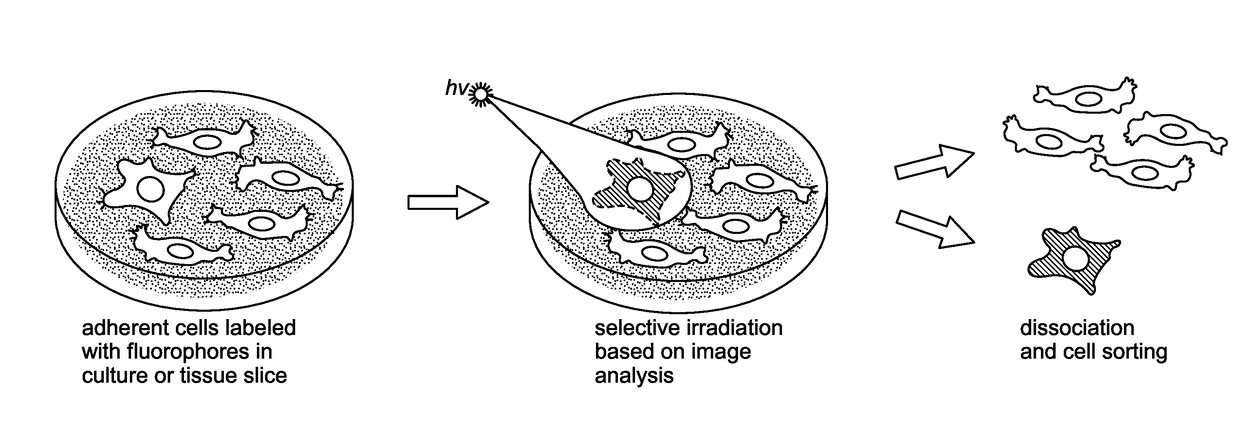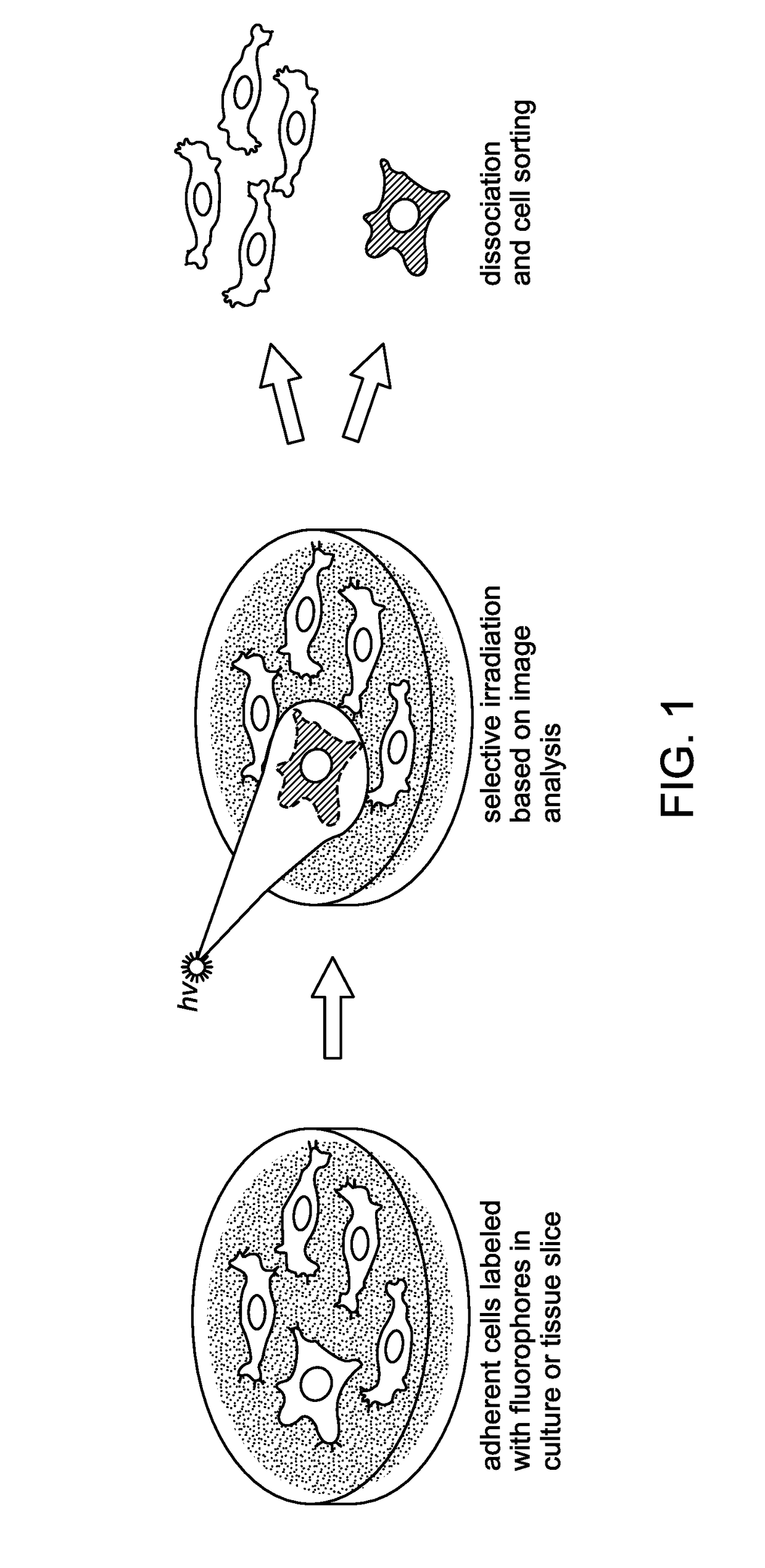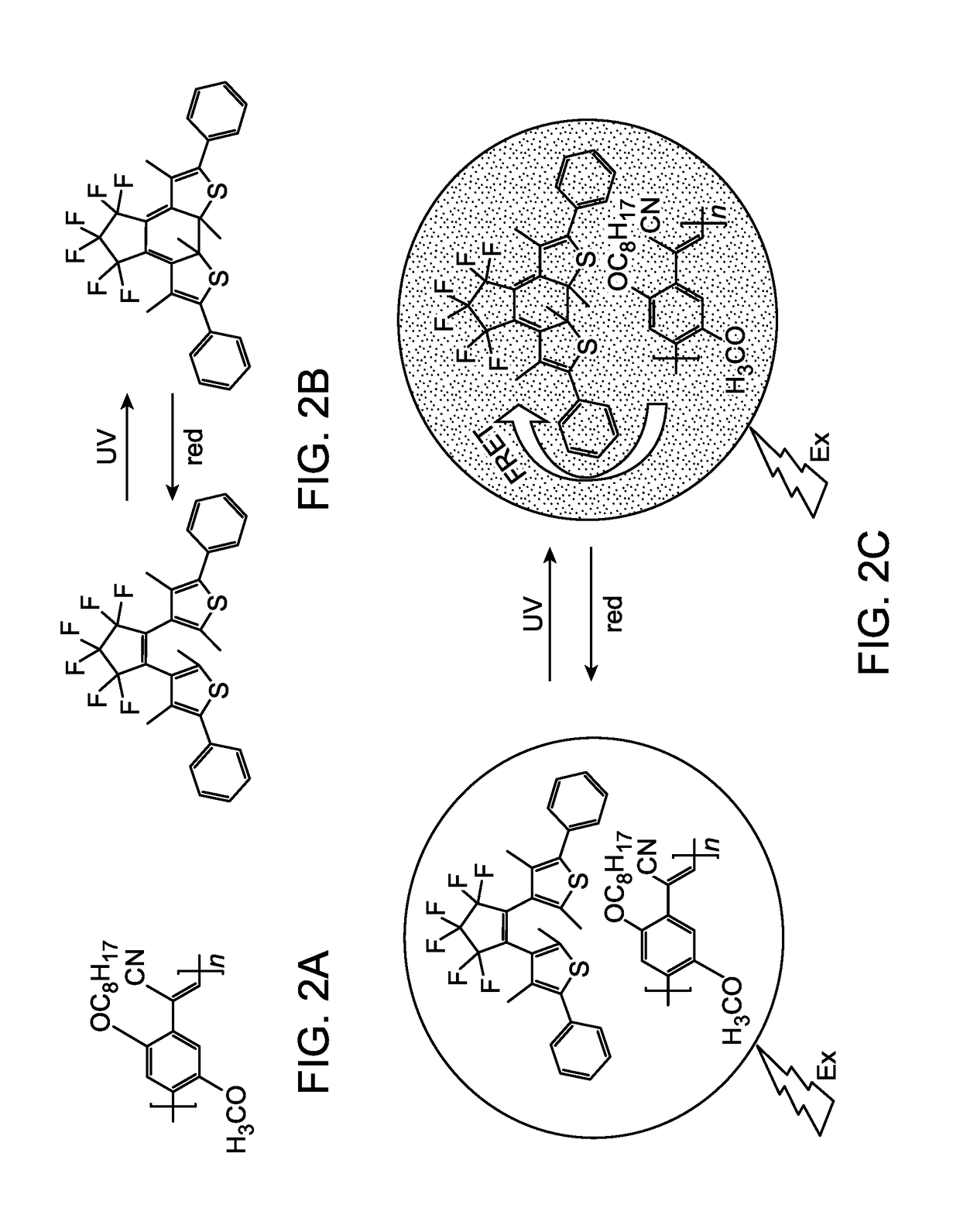Optical painting and fluorescence-activated sorting of adherent cells
a technology of adhesion cells and fluorescence, applied in fluorescence/phosphorescence, instruments, enzymology, etc., can solve the problems of microdissection potentially damaging or contaminating target cells
- Summary
- Abstract
- Description
- Claims
- Application Information
AI Technical Summary
Benefits of technology
Problems solved by technology
Method used
Image
Examples
example 1
Synthesis of Photoswitchable Chromophoric Polymer Particles
[0152]This example describes the synthesis of chromophoric polymer particles (also referred to herein as “Pdots”) with photoswitching capabilities. The Pdots included a chromophoric polymer and a photochromic quencher. The photochromic quencher acts as an energy acceptor and quenches the polymer's fluorescence via Förster resonance energy transfer (FRET). The photo-induced conversion of the photochromic quencher controls the absence or presence of FRET, resulting in the ON-OFF switching of the polymer fluorescence
[0153]All of the chemicals and solvents were purchased from Sigma-Aldrich (St. Louis, Mo.) unless indicated otherwise. The fluorescent semiconducting polymer poly[2-methoxy-5-2-ethylhexyloxy]-1,4-(1-cyanovinylene-1,4-phenylene)] (CN-PPV, MW 15,000, polydispersity 5.9) was purchased from ADS Dyes, Inc. (Quebec, Canada). The photochromic quencher 1,2-bis(2,4-dimethyl-5-phenyl-3-thienyl)-3,3,4,4,5,5,-hexafluoro-1-cyclo...
example 2
Photoswitching Performance of Cells Labeled with Photoswitchable Chromophoric Polymer Particles
[0170]This example describes characterization of the photo switching performance of cells labeled with CN-PPV-BTE Pdots produced as described in Example 1 above. To turn cells “ON” and make them fluorescent with 633-nm irradiation, the surfaces of MCF-7 cells were labeled with CN-PPV-BTE-streptavidin (CN-PPV-BTE-SA) Pdots using a biotinylated primary antibody against EpCAM. EpCAM is the epithelial cell surface marker used for the isolation of tumor cells that exhibit epithelial characteristics. Flow cytometry was used to quantify the photoswitching performance of Pdot-labeled cells.
[0171]The breast cancer cell line MCF-7 cell and cell culture medium were purchased from American Type Culture Collection (Manassas, Va.). The MCF-7 cells were cultured at 37° C. with 5% CO2 in Eagle's minimum essential medium (EMEM) (with L-glutamine) supplemented with 10% fetal bovine serum and 1% penicillin (...
example 3
Optical Painting of Individual Adherent Cells Labeled with Photoswitchable Chromophoric Polymer Particles
[0176]This example describes optical painting of individual cells labeled with the Pdots described in Examples 1 and 2. To demonstrate the optical painting approach (see FIG. 1), MCF-7 cells grown on a Petri dish were labeled with photoswitchable CN-PPV-BTE-SA Pdots bound to biotinylated anti-EpCAM antibodies. From a practical perspective, cells were labeled with OFF-state Pdots, which were generated by the irradiation of a bulk Pdot sample with UV light prior to cellular labeling. This way, cells were not affected by the UV irradiation needed to turn off Pdots during the painting process. Next, individual cells that were imaged and selected under a microscope were turned on.
[0177]Cellular imaging was performed by an in-house fluorescence microscope with a 488-nm laser source under ambient conditions. A 633-nm laser was focused to a spot size of 10 μm in diameter for single-cell ...
PUM
| Property | Measurement | Unit |
|---|---|---|
| emission wavelength | aaaaa | aaaaa |
| emission wavelength | aaaaa | aaaaa |
| emission wavelength | aaaaa | aaaaa |
Abstract
Description
Claims
Application Information
 Login to View More
Login to View More - R&D
- Intellectual Property
- Life Sciences
- Materials
- Tech Scout
- Unparalleled Data Quality
- Higher Quality Content
- 60% Fewer Hallucinations
Browse by: Latest US Patents, China's latest patents, Technical Efficacy Thesaurus, Application Domain, Technology Topic, Popular Technical Reports.
© 2025 PatSnap. All rights reserved.Legal|Privacy policy|Modern Slavery Act Transparency Statement|Sitemap|About US| Contact US: help@patsnap.com



